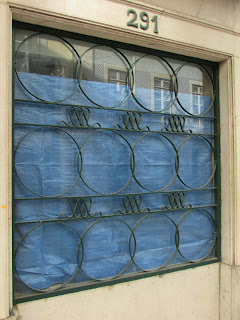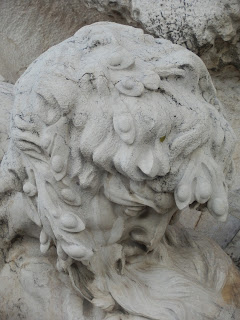I was last in Lisbon far too many years ago, as a young slip of a lad whilst interrailing with student friends. With the London weather doing its worst in January, I decided a return visit was long overdue, and so packed a bag and flew south to the Portugese capital in search of better weather and some inspirational art.
There were lots of wonderful large period buildings, many now sadly abandoned to the elements and grafitti artists, which spoke of a once prosperous past. They were like grand old dames who had fallen on hard times, but who still managed to retain an air of grandeur. Happily there seems to be a lot of renovation and restoration work going on behind the crumbly facades, so these period buildings are being saved and given a new lease of life. There were also many examples of Art Nouveau and Art Deco architecture which is a period in art and design that I particularly admire. It was a pleasant surprise to see an Art Nouveau period Metro station still in service in Lisbon. They were originally designed by Hector Guimard and usually found in Paris.
I kept returning to this church. There was a real feeling of peace and serenity inside. It looked as though there had been a fire inside that had affected and blackened the stone-work. I am not sure if it is a survivor of the massive earthquake of 1755 that devastated the city, but I like that they hadn't attempted to over-restore it, and kept the blackened stone-work largely as a reminder of its past.
The Portugese love their decoration. Many buildings are covered in azulejos - the lovely hand-painted ceramic tiles which adorn buildings all over the city. Some examples of these tile designs go back as far as 500 years. Other examples of Portugese decoration can be seen with stucco reliefs or detailed, decorative carved stonework on buildings.
There is also lots of elegant wrought ironwork which still remains on the building facades protecting the gates and windows. Thankfully this wasn't removed on a large scale during the wartime era and melted down for ammunition as in other European countries.
There were also some stunning examples of statuary on display which the Portugese do so very well.
Being based on the river Tagus there are big skies, the air is fresh and has a certain sweetness to it that you don't get in London.
I loved the rattle and clatter of the old yellow trams which wended their noisy way around the city. They are full of character, and integral to the charm and identity of Lisbon.
On the tram from Belem I encountered this dapper old gent. He was full of old school charm, and immaculately dressed with his fedora, silk scarf, leather gloves, pocket handkerchief and highly polished shoes. He was like a well-preserved relic from a completely different, more refined age.
His manners were just as impeccable as his dress sense, as he was, to his credit, the only man who despite his advanced years, stood up to offer his seat to the women who got on the tram. Had my Portugese language skills been stronger I would have loved to engage him in conversation to find out about his life.
Cakes and pastries of course are a Portugese institution. I had more than my fill of the sweet little custard pasteis de natas. I would get very fat if I lived there!
I really enjoyed the time spent in Lisbon. It was very fruitful, both enlightening and inspiring. I returned to London revived for having seen some art and sunshine and I look forward to a return visit in the near future. More on Lisbon in my next post.













































